 Pirates and Privateers Pirates and Privateers
The History of Maritime
Piracy
Cindy Vallar, Editor
& Reviewer
P.O. Box 425,
Keller, TX 76244-0425
    
In Memoriam
Verboten!
by Cindy Vallar
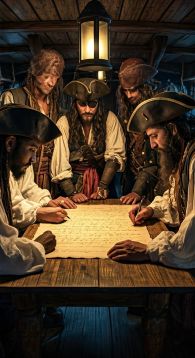 Look
at any of the surviving articles of agreement under
which pirates sail, and you’ll notice that some are
warnings to the crew. Harmony amongst themselves,
otherwise discord erupts and chaos reigns. This is
why some crews forbid women on their ships. Look
at any of the surviving articles of agreement under
which pirates sail, and you’ll notice that some are
warnings to the crew. Harmony amongst themselves,
otherwise discord erupts and chaos reigns. This is
why some crews forbid women on their ships.
No Boy or
Woman to be allowed amongst them. If any Man
were found seducing any of the latter Sex, and
carried her to Sea, disguised, he was to suffer
Death. (Johnson, 171)
When ships were captured
and women were found aboard, as happened when
Bartholomew Roberts’s men took Onslow, “they
put a Centinel immediately over her to prevent ill
Consequences from so dangerous an Instrument of
Division and Quarrel.” (Johnson, 171) Note: This
wasn’t done to protect the lady; rather, it was done
to keep the men from arguing or fighting amongst
themselves. Nor did this mean the lady was safe from
molestation. “[T]hey contend who shall be Centinel,
which happens generally to one of the greatest
Bullies, who, to secure the Lady’s Virtue, will let
none lye with her but himself.” (Johnson, 171)
This practice came back to haunt William Mead and
David Simpson. According to her testimony, Elizabeth
Trengove swore Mead
was very
rude to her, swearing and cursing, as also
forcing her hoop’d Petticoat off; and to prevent
more of his Impudence, which she was afraid off,
went down into the Gunner’s Room by Advice of
one Mitchel a Pyrate. (Full,
34)
She did as Mitchel bid,
but other pirates witnessed her passage through the
ship. Their threats brought Roberts to the scene and
he ordered her locked up until he had time to decide
her outcome. The guard he assigned to protect her,
Quartermaster David Simpson, assaulted her. At his
trial, he denied none of the facts and was judged
guilty. He was hanged on 3 April 1722, “without the
Gates of the Castle . . . [his] Body hung in
Chains.” (Full, 24) Simpson supposedly walked
to the
Gallows without a Tear . . . at seeing a Woman
that he knew, said, ‘he had lain with that B—h
three times, and now she was come to see him
hanged.’ (Johnson, 258)
The court decided the
king should decide the outcome of Mead’s fate, so he
was sent back to Marshalsea, a prison in
England. Mitchel might have been John Mitchell, who
was judged guilty and condemned to serve seven years
of hard labor, which essentially was a death
sentence in Africa.
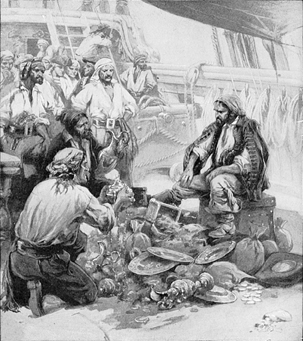 Pirates of the nineteenth century
tended to be more brutal than their earlier
counterparts. Their catchphrase seemed to be “Dead
men tell no tales.” And their idea of “fun” was
certainly not how the victims defined that word. In
1828, Benito de Soto gave orders to
sink Morning Star, but not before his men
plundered the ship and the women aboard. When the
pirates boarded, Annie Logie, one of the military
wives bound for home, locked herself and the other
women and their children in the roundhouse, but
later admitted, Pirates of the nineteenth century
tended to be more brutal than their earlier
counterparts. Their catchphrase seemed to be “Dead
men tell no tales.” And their idea of “fun” was
certainly not how the victims defined that word. In
1828, Benito de Soto gave orders to
sink Morning Star, but not before his men
plundered the ship and the women aboard. When the
pirates boarded, Annie Logie, one of the military
wives bound for home, locked herself and the other
women and their children in the roundhouse, but
later admitted,
We had no
means to defend ourselves barricaded in there,
all the while hearing shouts in foreign tongues.
Later our menfolk were forced below into the
cargo hold by the attackers and the hatch covers
were hammered shut. (Ford, 70)
She warned the women not
to resist, and when the leader demanded that she be
brought to him, she went.
Passing
her infant to one of the women, she slid open
the iron door lock and was half-dragged onto the
sunlit quarterdeck . . . [and] was shoved
roughly towards the makeshift canopy of torn
sailcloth draped over a spar where Barbazan sat.
(Ford, 72-73)
As far as the pirates
were concerned, it was time to celebrate. The ship’s
cook cooked “four fowl from the hen cook” and
stemware was taken from the captain’s cabin to drink
from. While the pirates imbibed, Anne prayed that
they would become so intoxicated that they would
pass out. It was not to be.
As dusk
fell, reeking of sweat and wine, Barbazan leered
at Anne Logie, shoving a wine bottle at her,
fondling her with a greasy hand, and when her
husband lunged towards Barbazan, he was
overpowered by two of the pirates who dragged
him towards the cargo hatch. (Ford, 74)
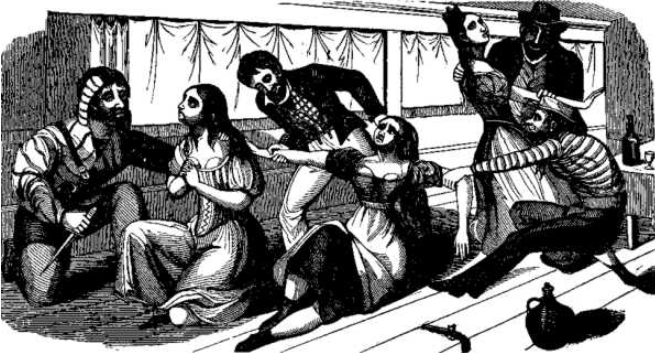
Women suffer at hands of
pirates aboard Morning Star
(Source: The Pirates Own Book
by Charles Ellms, 1837)
Anne and the others suffered until the drink finally
knocked the pirates senseless. It was a short
reprieve, because the next morning Captain Benito de
Soto, who was still aboard the pirate ship, ordered
his men to lock up all the captives and drill holes
in Morning Star’s hull. Instead of waiting
to make certain she sank, the pirates sailed away.
The women managed to escape from the roundhouse and
free their husbands and the crew. Together, they
manned the pump and kept the ship afloat long enough
for a passing vessel to rescue them several days
later.
As despicable as such encounters were, pirates were
more likely to follow the adage of all’s fair in
love and war, and pirates of the golden age and
later made it clear that they were the enemies of
all mankind . . . at sea. It was often a different
story when they were on land.
While women, for the most part, were excluded from
pirate ships per the companies’ articles, they were
a welcome sight when pirates went ashore with money
to burn. The 1680 census of Port Royal, Jamaica,
mentioned only a single brothel among the many
structures in the city. The proprietor was John
Starr, and his workers included twenty-three women
and two Blacks. There must have been other such
establishments, but they were either significantly
smaller or within buildings where selling ale or
punch was the primary business.
For law-abiding people, Port Royal was so bad that it
was likened to the biblical city of Sodom because of the
proliferation of taverns, ordinaries, and brothels.
The latter included
‘such a
crew of vile strumpets, and common prostitutes,
that tis almost impossible to civilize’ the
town, since they were ‘its walking plague,
against which neither cage, whip nor
ducking-stool would prevail.’ (Preston, 28)
These women weren’t
necessarily raving beauties.
In their
smockes ore linen peticotes, bare-footed without
shoes or stockins, with a straw hatt and a red
tobacco pipe in their mouths, [they would]
trampouse about their streets in this their
warlike posture, and thus arrayed will booze a
cupp of punch cumly with anyone. (Pawson,
144)
Some pirates ventured
into Betty Ware’s tavern where, once inebriated,
they would cross cutlasses in front of women who
spoke and behaved more like men. They had names like
Buttock-de-Clink Jenny, No-Conscience Nan, and
Salt-Beef Peg. One of the most famous was Mary Carleton, also known as
the German Princess because she assumed such a role
after a case of mistaken identity.
Decking
herself in jewels and finery and passing as
Maria de Wolway, she came to London as a noble
German lady forced to flee an unwanted marriage.
Her appearance of wealth was aided by false
letters from the continent attesting to estates.
(Todd)
She married a man named
Carleton in 1663, who hoped to gain those
properties. When he didn’t and Mary’s true identity
became known, she was arrested and tried on charges
of bigamy. She never swayed from her story during
the trial; she even turned the tables on Carleton,
saying he was the one spreading lies. She was
acquitted, had several lovers, and changed her
identity several more times. Later, she filched a
silver tankard and got caught. A jury sentenced her
to hang; instead, she was transported to Port Royal
in 1671. (Transport became more common two decades
later because so many strumpets were crowding gaols.
It cost the Crown £8 per person to send them
overseas.)
She left an impression on those who frequented Port
Royal. A contemporary said:
A stout
frigate she was or else she never could have
endured so many batteries and assaults . . . she
was as common as a barber’s chair: no sooner was
one out, but another was in. (Preston, 28)
Even after Mary returned
to London, she continued her deceits and thievery,
which again landed her in jail. This time around,
she didn’t escape the hangman’s noose on 22 January
1673.
The most powerful pirate in Asian waters was once a
prostitute. She was visited by the pirate Zheng Yi,
who commanded the Red Flag Fleet. He asked her to be
his wife, but she agreed to do so only if she
received an equal portion of plunder and if he
treated her as his equal. Zheng Yi Sao would later
become powerful enough to threaten the existence of
the imperial navy, and her influence and success
eventually allowed her to dictate the terms of her
retirement with the Chinese emperor.
Whereas Western pirates frequented brothels on land,
many brothels in China were found on the water. Karl
Gützlaff, a nineteenth-century German missionary,
wrote,
As soon as
we had anchored, numerous boats surrounded us,
with females on board, some of them brought by
their parents, husbands, or brothers. I
addressed the sailors who remained in the junk,
and hoped that I had prevailed on them, in some
degree, to curb their evil passions. But, alas!
no sooner had I left the deck, than they threw
off all restraint; and the disgusting scene
which ensued, might well have entitled our
vessel to the name of Sodom. (Gutzlaff, 88)
The floating brothels in
Canton were known as “flower boats,” and in 1770,
estimates placed the number of such establishments
at 8,000.
Some historians have suggested that some pirates
preferred to rendezvous with other men. Among
Western pirates, David Cordingly wrote, “it seems
likely that the percentage of pirates who were
actively homosexual was similar to that in the Royal
Navy, and reflected the proportion of homosexuals in
the population at large.” (163) Benerson Little has
“come across little to support” the opinion that
pirates “were actually active homosexual
communities.” His research suggests the opposite.
(Little, Sea, 209)
In Asia, however, the lines among personal
relationships between pirates and their mates or
pirates and captives was more blurred. Having more
than one partner wasn’t unusual. When Zhang Bao was
a young boy, he was taken captive by Zheng Yi. The
pirate chief took Zhang Bao under his wing, teaching
him to be a pirate and bonding with him personally
to keep him loyal. After Zheng Yi’s death, Zhang Bao
became Zheng Yi Sao’s lover; she had been his
adoptive mother since she was married to Zheng Yi.
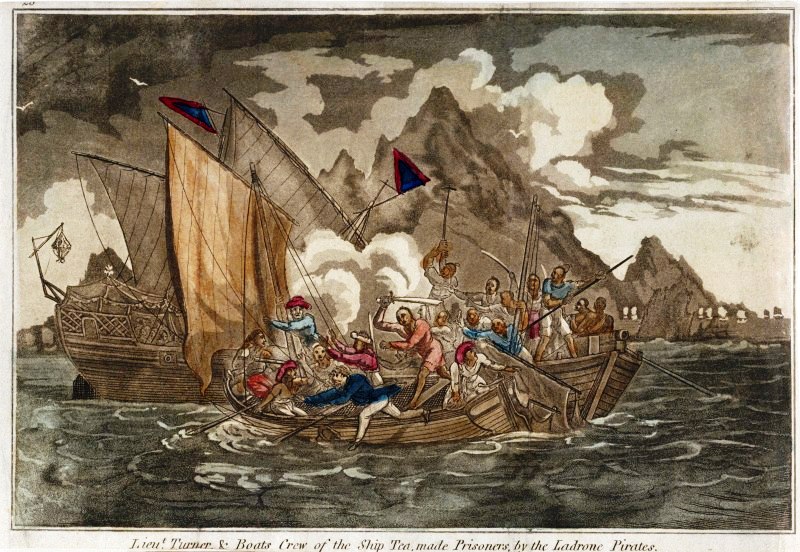
Pirates capture John Turner by
unknown artist, circa 1807
(Source: Wikimedia Commons)
J. L. Turner, an Englishman
serving as first mate of a trading ship, found
himself the prisoner of Cheng Yat in 1806. He
observed the Red Flag Fleet’s treatment of women.
With
respect to the women who fall into their hands,
the handsomest are reserved by them for wives
and concubines; the chiefs and captains having
frequently three or more, the others seldom more
than one; and having once made the choice of a
wife, they are obliged to be constant to her, no
promiscuous intercourse being allowed amongst
them. (Turner, 13)
A contemporary of Zheng Zhilong mentions that
“As a young man, [he] was pleasing to the eye, and
Li Dan took him as his male lover.” (Andrade, 25)
Whether this was true or not cannot be determined
because the biographer was relatively unknown and no
documentary evidence exists to prove or disprove the
statement. At the time, though, homosexuality was a
common practice among seventeenth-century seafarers
in the Fujian region of China. That said, Zheng
Zhilong did have two wives, one Chinese and one
Japanese.
Illicit trysts weren’t the only forbidden items that
pirates enjoyed. Some were dangerous to the pirates’
health. Opium’s addictiveness
eventually led to war between Imperial China and
Great Britain. Asian pirates often chewed betel nuts to pass the time.
Chewers were easy to spot because the pirates’
smiles would be deep red or purple. The pirates who
captured Edward Brown, a seaman taken
captive in the 1850s, tried to share the betel-net,
which they called “eu-kow-ong,” with him.
When I
declined it, they appeared quite surprised, and
would not be satisfied that I did not use it;
but asked to look at my teeth, and showed
symptoms of disgust at their natural white
colour, at the same time pointing to their own,
which were as black as ebony. They chew this
nauseous nut all day long, and only take it out
of their mouths while they are eating. . . .
Black teeth are
with them an embellishment, rather than a
disfigurement; they are coveted as much by them,
as a good head of hair is by the English; and
they are a necessary adjunct to opulence and
respectability. (Brown, 117-118)
In modern times, Somali
pirates prefer khat, a stimulant that can be
chewed or brewed as tea. Chewing is the preferable
way to partake of this “flower of paradise,” and the
pirates will chew it for hours while with their
friends. The bitter taste often compels them to
drink highly sweetened tea or 7UP. When experiencing
the euphoria that khat produces, pirates tend to
think they are invincible. According to Abdirizak
Ahmed, “I would either become relaxed and talkative,
or a sex-crazy maniac bent on immediate satiation.”
(Bahadur, 93)

Montage of Somali pirates that
captured MV Faina
by Mass Communication Specialist 2nd
Class Jason R. Zalasky, 2008
(Source: Wikimedia Commons)
Smoking was another habit among Asian pirates, and
Edward Brown did join them.
[T]hey
offered me paper cigars, which I gladly
accepted; but when they gave me the materials,
they were surprised that I could not roll them
as neatly as they did themselves. (Brown,
118)
Western pirates also
liked to smoke, although their preference was pipe smoking. Among the
artifacts recovered from Queen Anne’s Revenge
were pipes of white clay. After getting caught with
Stede Bonnet, David Herriot
said that they “took two Ships bound from Virginia
for Glascow . . . and took about one hundred Weight
of Tobacco out of each . . . .” (Tryals of Major,
46) It was plunder frequently taken that was easily
and immediately divided amongst the pirates for
their enjoyment. Smoking was so common that John Philips made mention of
it in his company’s articles.
 That Man shall snap his Arms, or
smoak Tobacco in the Hold, without a cap to his
Pipe, or carry a Candle lighted without a
Lanthorn, shall suffer the same Punishment as in
the former Article. (In, 222 n255) That Man shall snap his Arms, or
smoak Tobacco in the Hold, without a cap to his
Pipe, or carry a Candle lighted without a
Lanthorn, shall suffer the same Punishment as in
the former Article. (In, 222 n255)
The aforesaid punishment
was “Moses’ Law (that is 40 stripes lacking one) on
the bare Back.” (In, 222, n255)
Phillips was one of those who used tobacco on his
ship. Among the articles taken from him after his
capture, was “a curious tobacco box.” (Pirates, 233)
Tobacco was such a fixture in pirates’ lives that
they even smoked it when trying would-be deserters
who sailed with Bartholomew Roberts.
The Place
appointed for their Tryals, was the Steerage of
the Ship; in order to which, a large Bowl of Rum
Punch was made, and placed upon the Table, the
Pipes and Tobacco being ready, the judicial
Proceedings began; the Prisoners were brought
forth, and Articles of Indictment against them
read; they were arraigned upon a Statute of
their own making, and the Letter of the Law
being strong against them, and the Fact plainly
proved, they were about to pronounce Sentence,
when one of the Judges mov’d, that they should
first Smoak t’other Pipe; which was accordingly
done.
The pause permitted one
pirate to stand up in defense of one of the
defendants. After some more smoking and further
deliberation, the other judges concurred that Henry
Glasby would escape punishment. As to the remaining
defendants, the pirates were adamant that they must
be punished, but they were permitted to choose their
own executioners before being “ty’d immediately to
the Mast, and there shot dead . . . .” (Johnson,
185-187)
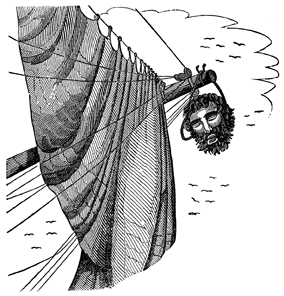 Roberts’s motto of “a merry Life and
a short one” proved merry for those standing in
judgment and a short one for those brought before
the bar. Of course, pirates weren’t the only ones
who liked to celebrate, especially if the merriment
showed exactly what victims of piracy thought about
the perpetrators of their misfortune. Roberts also
suffered a short life, being shot in the throat
after plundering the seas for only three years.
Blackbeard’s comeuppance came after about a year and
a half of terrorizing victims. He died during an
engagement with Lieutenant Robert Maynard and his
men in November 1718. Thache’s head was then severed
from his body and hung from the bowsprit of
Maynard’s sloop. Roberts’s motto of “a merry Life and
a short one” proved merry for those standing in
judgment and a short one for those brought before
the bar. Of course, pirates weren’t the only ones
who liked to celebrate, especially if the merriment
showed exactly what victims of piracy thought about
the perpetrators of their misfortune. Roberts also
suffered a short life, being shot in the throat
after plundering the seas for only three years.
Blackbeard’s comeuppance came after about a year and
a half of terrorizing victims. He died during an
engagement with Lieutenant Robert Maynard and his
men in November 1718. Thache’s head was then severed
from his body and hung from the bowsprit of
Maynard’s sloop.
When the
vessel which captured Blackbeard returned to
Virginia, they set up his head on a pike planted
at “Blackbeard point,” then an island.
Afterwards, when his head was taken down, his
skull was made into the bottom part of a very
large punch bowl, called the infant, which was
long used as a drinking vessel at the Raleigh
tavern at Williamsburg. It was enlarged with
silver, or silver plated; and I have seen those
whose forefathers have spoken of drinking punch
from it, with a silver ladle appurtenant to that
bowl. (Watson, 2: 221)
Fact or fiction, who’s to
say? Does it matter? It makes for a great story, and
at the time, more than a few colonists were happy to
celebrate the demise of the most notorious pirate of
the day.
Resources:
“America
and West Indies: March 1678,’ in Calendar
of State Papers Colonial, America and West
Indies: Volume 10,1677-1680 edited by W.
Noel Sainsbury and J. W. Fortescue. London, 1896,
220-231 (March-Sept. St. Christopher’s. 645.)
“America
and West Indies: August 1698, 22-25,’ in Calendar
of State Papers Colonial, America and West
Indies: Volume 16,1697-1698 edited by J. W.
Fortescue. London, 1905, 399-406 (Aug. 25. 771.).
“America
and West Indies: June 1718,” in Calendar of
State Papers Colonial, America and West Indies:
Volume 30, 1717-1718 edited by Cecil Headlam.
London, 1930, 264-287. (June 18. Charles Towne,
South Carolina. 556.).
Andrade, Tonio.
Lost Colony: The Untold Story of China’s First
Great Victory Over the West. Princeton,
2011.
Antony, Robert J. Like
Froth Floating on the Sea: The World of Pirates
and Seafarers in Late Imperial China.
Institute of East Asian Studies, University of
California Berkley, 2003.
Appleby, John C. Women
and English Piracy 1540-1720: Partners and
Victims of Crime. Boydell, 2013.
Ashmead, Henry Graham.
History
of Delaware County, Pennsylvania. L.
H. Everts & Co., 1884.
Bahadur, Jay. The Pirates of Somalia: Inside
Their Hidden World. Pantheon Books, 2011.
Bialuschewski, Arne. Raiders
and Natives: Cross-cultural Relations in the Age
of Buccaneers. University of Georgia, 2022.
Bold in Her
Breeches: Women Prostitutes Across the Ages
edited by Jo Stanley. Pandora, 1996.
Borvo, Alain. “Discover
Aluette, the Game of the Cow,” Traditional
Tarot (21 July 2021).
Bradley, Peter T. Pirates
on the Coasts of Peru 1598-1701.
Independently published, 2008.
Brooks, Baylus C. Quest
for Blackbeard: The True Story of Edward Thache
and His World. Independently published,
2016.
Brown, Edward. A
Seaman’s Narrative of the Adventures During a
Captivity Among Chinese Pirates, on the Coast
of Cochin-China. Charles Westerton,
1861.
Burg, B. R. “The
Buccaneer Community” in Bandits at Sea: A
Pirates Reader edited by C. R. Pennell. New
York University, 2001, 211-243.
Choundas, George. The Pirate Primer: Mastering
the Language of Swashbucklers and Rogues.
Writer’s Digest, 2007.
Codfield, Rod. “Tavern
Tales: 1708 Letter,” Historic London
Town & Gardens (2 April 2020).
Cotton, Charles. The
Compleat Gamester. London: Charles Brome,
1710.
Craze, Sarah, and Richard Pennell. “The Truth Behind a Pirate Legend,”
Pursuit (23 March 2021).
Croce, Pat. The
Pirate Handbook. Chronicle Books, 2011.
Dampier, William. A New
Voyage Round the World vol. 1. London:
James Knapton, 1699.
Defoe, Daniel. A
General History of the Pyrates edited by
Manuel Schonhorn. Dover, 1999.
Duffus, Kevin P. The
Last Days of Black Beard the Pirate. Looking
Glass Productions, 2008.
Eastman, Tamara J., and Constance Bond. The
Pirate Trial of Anne Bonny and Mary Read.
Fern Canyon Press, 2000.
Ellms, Charles. The
Pirates Own Book. 1837.
Esquemeling, John. The Buccaneers of America.
Rio Grande Press, 1684.
Exquemelin, Alexander
O. The Buccaneers of America translated by
Alexis Brown. Dover, 1969.
“FAQs:
Beverages,” Food Timeline edited by
Lynne Olver (30 November 2021).
Ford, Michael. “The
Attack of the ‘Last Great Pirate’ – Benito De
Soto, Wellington’s Treasure and the Raid of the
‘Morning Star,’ Military History Now
(21 June 2020).
Ford, Michael E. A. Hunting
the Last Great Pirate: Benito de Soto and the
Rape of the Morning Star. Pen & Sword,
2020.
A Full
and Exact Account of the Tryal of the Pyrates
Lately Taken by Captain Ogle. London:
J. Roberts, 1723.
Fox, Edward Theophilus. “’Piratical Schemes and
Contracts’: Pirate Articles and their Society,
1660-1730.” PhD thesis, University of
Exeter, 2013.
Further
State of the Ladrones on the Coast of China.
Lane, Darling, and Co., 1812.
Geanacopulos, Daphne Palmer. The Pirate Next
Door: The Untold Story of Eighteenth Century
Pirates’ Wives, Families and Communities.
Carolina Academic, 2017.
Gosse, Philip. The Pirates’ Who’s Who. Rio
Grande Press, 1924.
Gutzlaff,
Charles. Three
Voyages Along the Coast of China in 1831,
1832, & 1833. Frederick, Westley
and A. H. Davis, 1834.
Hacke, William. Collection
of Original Voyages. London: James
Knapton, 1699.
Hailwood, Mark. “‘Come
hear this ditty’: Seventeenth-century
Drinking Songs and the Challenges of Hearing the
Past,” The Appendix (10 July 2013).
Hardy, Thomas. “Drinking
Song,” Poetry Nook.
Hartsmar, Markus. “Oscar
Wilde, 1854-1900,” Absinthe.se.
Hughes, Ben. Apocalypse
1692: Empire, Slavery, and the Great Port Royal
Earthquake. Westholme, 2017.
Jacob, Robert. “Popular
Games from the Golden Age!” Robert Jacob.
Jamaica Rose. “Games
Pirates Played,” Pirates Magazine (Summer
2006), 53-55.
Jamaica Rose. “Pirate
Pastimes & Pleasures,” Pirates Magazine
(Summer 2006), 49-51.
Jameson, John Franklin.
Privateering
and Piracy in the Colonial Period:
Illustrative Documents. Macmillan, 1923.
Johnson, Charles. A General
History of the Robberies and Murders of the Most
Notorious Pyrates. London: C. Rivington,
1724.
Kehoe, M. “Booze,
Sailors, Pirates and Health in the Golden Age of
Piracy,” The Pirate Surgeon’s Journals:
Tools and Procedures.
Kehoe, M. “Christmas
Holidays at Sea in the Golden Age of Piracy,”
The Pirate Surgeon’s Journals: Tools and
Procedures.
Kehoe, Mark C. “Fresh
Water at Sea in the Golden Age of Piracy,” The
Pirate Surgeon’s Journals.
Kehoe, M. “Tobacco
and Medicine During the Golden Age of Piracy,”
The Pirate Surgeon’s Journals: Tools and
Procedures.
Kelleher, Connie. The
Alliance of Pirates: Ireland and Atlantic Piracy
in the Early Seventeenth Century. Cork
University, 2020.
King
James Bible Online.
Labat, Jean-Baptiste. The
Memoirs of Père Labat, 1693-1705
translated and abridged by John Eaden.
Routledge, 2013.
Lane, Kris E. Pillaging the Empire:
Piracy in the Americas, 1500-1750. M. E.
Sharpe, 1998.
Lee, Robert E. Blackbeard
the Pirate: A Reappraisal of His Life and Times.
John F. Blair, 2002.
“Liar’s
Dice,” Awesome Dice.
Little, Benerson. The
Buccaneer’s Realm: Pirate Life on the Spanish
Main, 1674-1688. Potomac Books, 2007.
Little, Benerson. “Of
Buccaneer Christmas, Dog as Dinner, & Cigar
Smoking Women,” Swordplay &
Swashbucklers (1 January 2017).
Little, Benerson. The
Sea Rover’s Practice: Pirate Tactics and
Techniques, 1630-1730. Potomac Books, 2005.
Marley, David F. Pirates of the Americas
Volume 1 1650-1685. ABC Clio, 2010.
Marley, David F. Pirates
of the Americas Volume 2 1686-1725. ABC
Clio, 2010.
Mather, Increase. Wo to
Drunkards (second edition). Boston:
Timothy Green, 1712.
McAlister, Zac. “What Is
Black Strap Rum,” Booze Bureau.
Neumman, Charles Fried. History
of the Pirates Who Infested the China Sea,
from 1807 to 1810. Oriental
Translation Fund, 1831.
Parlett, David. “Historic
Card Games,” Games & Gamebooks.
2022.
Pawson, Michael, and
David Buisseret. Port Royal, Jamaica.
University of the West Indies, 2000.
“Pirate
Potheads? On Drugs and Tobacco in the Golden Age
of Piracy,” Gold and Gunpowder (8
December 2023).
The Pirate’s
Pocket-Book edited by Stuart Roberston.
Conway, 2008.
Pirates in Their Own
Words: Eye-witness Accounts of the ‘Golden Age’
of Piracy, 1690-1728 edited by E. T. Fox.
Fox Historical, 2014.
“The Plank
House,” The Marcus Hook Preservation
Society.
Preston, Diana and
Michael. A Pirate of Exquisite Mind: Explorer,
Naturalist, and Buccaneer: The Life of William
Dampier. Walker & Co., 2004.
Pruitt, Sarah. “How
Christmas Was Celebrated in the 13 Colonies,”
History (5 October 2023).
Rogers, Woodes. A
Cruising Voyage Round the World.
Cassell and Company, 1928.
Sanders, Richard. If a Pirate I must be . . .
: The True Story of “Black Bart,” King of the
Caribbean Pirates. Skyhorse, 2007.
Sanna, Antonio.
“Yo-ho-ho and a bottle of rum”: Representations of
Drunkenness in Literary and Cinematic Narratives
on Pirates,” Pirates in History and Popular
Culture edited by Antonio Sanna. McFarland,
2018, 120-131.
Schenawolf, Harry. “Music in
Colonial America,” Revolutionary War
Journal (21 August 2014).
Sharp, Bartholomew. Voyages
and Adventures of Capt. Barth. Sharp. P. A.
Esq., 1684.
Snelders, Stephen. “Smoke on
the Water: Tobacco, Pirates, and Seafaring
in the Early Modern World,” Intoxicating
Spaces: The Impact of New Intoxicants on Urban
Spaces in Europe, 1600-1850 (9 December
2019).
Snelgrave, William. A
New Account of Some Parts of Guinea, and the
Slave Trade. London: James, John, and Paul
Knapton, 1734.
Struzinski, Steven. “The
Tavern in Colonial America,” The
Gettysburg Historical Journal volume 1,
article 7 (2002), 29-38.
Sutton, Angela C. Pirates
of the Slave Trade: The Battle of Cape Lopez and
the Birth of an American Institution.
Prometheus, 2023.
Talty, Stephan. Empire of Blue Water: Captain
Morgan’s Great Pirate Army, the Epic Battle for
the Americas, and the Catastrophe That Ended the
Outlaws’ Bloody Reign. Crown, 2007.
Thomson, Keith. Born
To Be Hanged: The Epic Story of the Gentlemen
Pirates Who Raided the South Seas, Rescued a
Princess, and Stole a Fortune. Little,
Brown, 2022.
Todd. “Daily
Life of the American Colonies: The Role of
the Tavern in Society,” The Witchery Arts
(3 April 2015).
Todd, Janet. “Carleton,
Mary (1634x42-1673),” Oxford Dictionary of
National Biography. Oxford University, 2004.
The
Tryals of Captain John Rackham, and Other
Pirates. Jamaica: Robert Baldwin,
1721.
The
Tryals of Major Stede Bonnet, and Other
Pirates. London: Benj. Cowse, 1719.
“Tryals of Thirty-six
Persons for Piracy” in British Piracy in the
Golden Age: History and Interpretation,
1660-1730 edited by Joel H. Baer. Pickering
& Chatto, 2007, 3:167-192.
Turner, John. Sufferings
of John Turner, Chief Mate of the Country
Ship, Tay. Thomas Tegg, 1810.
Vallar, Cindy. “Pirates
and Music,” Pirates and Privateers
(18 September 2013).
Watson, John F. Annals
of Philadelphia and Pennsylvania in the Olden
Time, vol. 2. John Penington and Uriah
Hunt, 1844.
Wafer, Lionel. A New
Voyage and Description of the Isthmus of
America. London: James Knapton, 1699.
Wilde-Ramsing, Mark U.,
and Linda F. Carnes-McNaughton. Blackbeard’s
Sunken Prize: The 300-Year Voyage of Queen
Anne’s Revenge. University of North Carolina,
2018.
Winstead, Dave. “1/24/2024
Is ‘Eat, Drink, And Be Merry’ A Biblical
Concept?” FaithByTheWord (24 January
2024).
Yates, Donald. “Colonial
Drinks, 1640-1860,” Bottles and Extras
(Summer 2003), 39-41.
While I worked on
this article, my father passed away.
He shared his affinity for the water
and boats with me in my youth, which
helped awaken a desire to write about
pirates. This article is for him. Now
that you are at peace and without
pain, Dad, may you eat, drink, and be
merry.

Lee Aker
Rest in peace |

Copyright ©2024 Cindy
Vallar
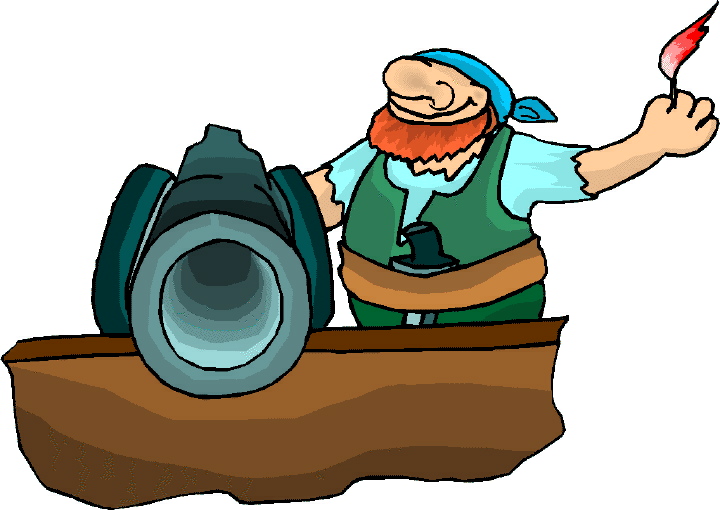
Click to contact me
Background image compliments
of Anke's Graphics |

